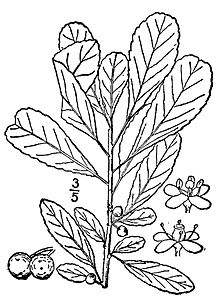Ilex decidua
| Ilex decidua | |
|---|---|

| |
| Scientific classification | |
| Kingdom: | Plantae |
| Clade: | Tracheophytes |
| Clade: | Angiosperms |
| Clade: | Eudicots |
| Clade: | Asterids |
| Order: | Aquifoliales |
| Family: | Aquifoliaceae |
| Genus: | Ilex |
| Species: | I. decidua
|
| Binomial name | |
| Ilex decidua | |

| |
| Synonyms | |
|
Ilex curtissii (Fern.) Small | |
Ilex decidua (meadow holly, also called "possumhaw", "deciduous holly" or "swamp holly") is a species of holly native to the United States.
Description

Distinguishing features of this species are crenate leaf margins and fruiting pedicels that are 2–8 mm long.[2] Its "distinctive leaf shape... is less variable than other species of holly".[3] Leaves are obovate,[4] simple, alternating, deciduous, and grow to 2.5-7.5 cm long.[3]
Drupe fruits are red (or rarely yellow), shiny, and globose (spherical, or nearly so), with a diameter of 4–8 mm.[2][3] The pulp is bitter; they contain 3-5 seeds and mature in autumn.[3]
Slender twigs are glabrous and silvery gray, with numerous spur shoots, pointed lateral buds, and acuminate scales.[3]
Bark is "light brown to gray" in color and may be smooth or "warty and roughened".[3]
Distribution and ecology

Ilex decidua is a common plant,[2] growing in the US in Alabama, Arkansas, Washington, D.C., Florida, Georgia, Illinois, Indiana, Kansas, Kentucky, Louisiana, Maryland, Missouri, Mississippi, North Carolina, Oklahoma, South Carolina, Tennessee, Texas, and Virginia.[5]
It grows in the northern Mexico states of Chihuahua and Coahuila.[6]
It prefers land in floodplains and the margins of swamps or lakes, and grows at elevations up to about 360 m.[2][3] Other plant species with which possumhaw is associated include water tupelo (Nyssa aquatica), overcup oak (Quercus lyrata), bald cypress (Taxodium distichum), sycamore (Platanus occidentalis) and hackberry (Celtis spp.).[7]
The fruits attract songbirds and small mammals.[4][8] Deer browse on young twigs.[3]
Human use

Because of the attractive "berries", the tree is used as a winter ornamental plant, and branches are collected for use as Christmas decorations.[3] The wood is not useful commercially because of the tree's small size.[3]
References
- ^ Stritch, L. (2018). "Ilex decidua". IUCN Red List of Threatened Species. 2018: e.T122927419A122927594. doi:10.2305/IUCN.UK.2018-1.RLTS.T122927419A122927594.en. Retrieved 3 May 2020.
- ^ a b c d Duncan, Wilbur H. and Marion B. Duncan (1988). Trees of the Southeastern United States. Athens, Georgia: The University of Georgia Press. pp. 304–305. ISBN 0-8203-1469-2.
- ^ a b c d e f g h i j Brown, Claud L.; L. Katherine Kirkman (1990). Trees of Georgia and Adjacent States. Portland, Oregon: Timber Press. pp. 178–179. ISBN 0-88192-148-3.
- ^ a b "NPIN: Ilex decidua (Possumhaw)". Retrieved 2009-07-14.
- ^ "PLANTS Profile for Ilex decidua (possumhaw)". Natural Resources Conservation Service. United States Department of Agriculture. Retrieved 2009-07-14.
- ^ "Ilex decidua". Germplasm Resources Information Network. Agricultural Research Service, United States Department of Agriculture. Retrieved 2009-07-14.
- ^ "FDEP Featured Plant: Florida Hollies". Florida Department of Environmental Protection. Retrieved 2009-07-14.
- ^ Little, Elbert L. (1980). The Audubon Society Field Guide to North American Trees: Eastern Region. New York: Knopf. pp. 561–62. ISBN 0-394-50760-6.
External links
![]() Media related to Ilex decidua at Wikimedia Commons
Media related to Ilex decidua at Wikimedia Commons
![]() Data related to Ilex decidua at Wikispecies
Data related to Ilex decidua at Wikispecies
- IUCN Red List least concern species
- Ilex
- Ornamental trees
- Trees of the Southeastern United States
- Trees of Chihuahua (state)
- Trees of Coahuila
- Trees of the North-Central United States
- Trees of the Southern United States
- Trees of the South-Central United States
- Trees of the Northeastern United States
- Trees of the Great Lakes region (North America)

